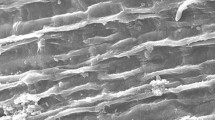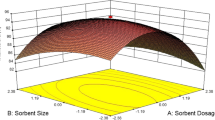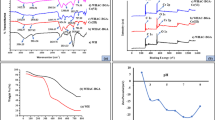Abstract
Solution pH appears to be the most important regulator of the biosorptive removal of chromium ions from aqueous solutions. This work presents a kinetic study of the effects of solution pH on Cr(VI) and total chromium removal from aqueous solution by Hass avocado shell (HAS) in batch and continuous packed bed column systems. Different Cr(VI) and total chromium removal performances of HAS were obtained in pH-shift batch, pH-controlled batch, and continuous systems. These results emphasize the great importance of determining the most appropriate pH for Cr(VI) and total chromium removal, considering the operational mode of the proposed large-scale treatment system. Total chromium biosorption batch kinetics was well described by the Elovich model, whereas in the continuous system, the fitness of the kinetic models to the experimental data was pH dependent. X-ray photoelectron spectroscopy and kinetic studies clearly indicated that the reaction mechanism of Cr(VI) with HAS was the reductive biotransformation of Cr(VI) to Cr(III), which was partially released to the aqueous solution and partially biosorbed onto HAS.







Similar content being viewed by others
References
Aksu Z, Gönen F, Demircan Z (2002) Biosorption of chromium (VI) ions by Mowital®B30H resin immobilized activated sludge in a packed bed: comparison with granular activated carbon. Process Biochem 38:175–186
Aranda-García E, Morales-Barrera L, Pineda-Camacho G, Cristiani-Urbina E (2014) Effect of pH, ionic strength, and background electrolytes on Cr(VI) and total chromium removal by acorn shell of Quercus crassipes Humb. & Bonpl. Environ Monit Assess 186:6207–6221
Arslan G, Pehlivan E (2007) Batch removal of chromium (VI) from aqueous solution by Turkish brown coals. Bioresour Technol 98:2836–2845
Basha S, Murthy ZVP (2007) Kinetic and equilibrium models for biosorption of Cr(VI) on chemically modified seaweed, Cystoseira indica. Process Biochem 42:1521–1529
Blanes PS, Bordoni M, González JC, García SI, Atria AM, Sala LF, Bellú SE (2016) Application of soy hull biomass in removal of Cr(VI) from contaminated waters. Kinetic, thermodynamic and continuous sorption studies. J Environ Chem Eng 4:516–526
Blázquez G, Hernáinz F, Calero M, Martin-Lara MA, Tenorio G (2009) The effect of pH on the biosorption of Cr(III) and Cr(VI) with olive stone. Chem Eng J 148:473–479
Cabatingan LK, Agapay RC, Rakels JLL, Otens M, van der Wielen LAM (2001) Potential of biosorption for the recovery of chromate in industrial wastewater. Ind Eng Chem Res 40:2302–2309
Calderón-Oliver M, Escalona-Buendía HB, Medina-Campos ON, Pedraza-Chaverri J, Pedroza-Islas R, Ponce-Alquicira E (2016) Optimization of the antioxidant and antimicrobial response of the combined effect of nisin and avocado byproducts. LWT-Food Sci Technol 65:46–52
Calero M, Hernáinz F, Blázquez G, Tenorio G, Martín-Lara MA (2009) Study of Cr (III) biosorption in a fixed-bed column. J Hazard Mater 171:886–893
Chatterjee A, Schiewer S (2011) Biosorption of cadmium(II) ions by citrus peels in a packed bed column: effect of process parameters and comparison of different breakthrough curve models. Clean-Soil Air Water 39:874–881
Chauhan D, Sankararamakrishnan N (2011) Modeling and evaluation on removal of hexavalent chromium from aqueous systems using fixed bed column. J Hazard Mater 185:55–62
Chen S, Yue Q, Gao B, Li Q, Xu X, Fu K (2012) Adsorption of hexavalent chromium from aqueous solution by modified corn stalk: a fixed-bed column study. Bioresour Technol 113:114–120
Cheung CW, Porter JF, McKay G (2000) Sorption kinetics for the removal of copper and zinc from effluents using bone char. Sep Purif Technol 19:55–64
Cheung CW, Porter JF, McKay G (2001) Sorption kinetic analysis for the removal of cadmium ions from effluents using bone char. Water Res 35:605–612
Cimino G, Passerini A, Toscano G (2000) Removal of toxic cations and Cr(VI) from aqueous solution by hazelnut shell. Water Res 34:2955–2962
Costa M (2003) Potential hazards of hexavalent chromium in our drinking water. Toxicol Appl Pharmacol 188:1–5
Cristiani-Urbina E, Netzahuatl-Muñoz AR, Cristiani-Urbina MDC (2011) Removal of hexavalent and total chromium from aqueous solution by avocado shell. Chem Eng Trans 24:1339–1344
Daneshvar N, Salari D, Aber S (2002) Chromium adsorption and Cr(VI) reduction to trivalent chromium in aqueous solutions by soya cake. J Hazard Mater 94:49–61
Das N, Vimala R, Karthika P (2008) Biosorption of heavy metals—an overview. Indian J Biotechnol 7:159–169
Dupont L, Guillon E (2003) Removal of hexavalent chromium with a lignocellulosic substrate extracted from wheat bran. Environ Sci Technol 37:4235–4241
El Nemr A, El-Sikaily A, Khaled A, Abdelwahab O (2015) Removal of toxic chromium from aqueous solution, wastewater and saline water by marine red alga Pterocladia capillacea and its activated carbon. Arab J Chem 8:105–117
Farooq U, Athar M, Khan MA, Kozinski JA (2013) Biosorption of Pb(II) and Cr(III) from aqueous solutions: breakthrough curves and modeling studies. Environ Monit Assess 185:845–854
Febrianto J, Kosasih AN, Sunarso J, Ju YH, Indraswati N, Ismadji S (2009) Equilibrium and kinetic studies in adsorption of heavy metals using biosorbent: a summary of recent studies. J Hazard Mater 162:616–645
Fellenz N, Perez-Alonso FJ, Martin PP, García-Fierro JL, Bengoa JF, Marchetti SG, Rojas S (2017) Chromium (VI) removal from water by means of adsorption-reduction at the surface of amino-functionalized MCM-41 sorbents. Microporous Mesoporous Mater 239:138–146
Fiol N, Escudero C, Poch J, Villaescusa I (2006) Preliminary studies on Cr(VI) removal from aqueous solution using grape stalk wastes encapsulated in calcium alginate beads in a packed bed up-flow column. React Funct Polym 66:795–807
Fiol N, Escudero C, Villaescusa I (2008) Chromium sorption and Cr(VI) reduction to Cr(III) by grape stalks and yohimbe bark. Bioresour Technol 99:5030–5036
Ghasemi M, Keshtkar AR, Dabbagh R, Jaber Safdari S (2011) Biosorption of uranium(VI) from aqueous solutions by Ca-pretreated Cystoseira indica alga: Breakthrough curves studies and modeling. J Hazard Mater 189:141–149
Gokhale SV, Jyoti KK, Lele SS (2009) Modeling of chromium (VI) biosorption by immobilized Spirulina platensis in packed column. J Hazard Mater 170:735–743
Hach Company (2008) Hach Water Analysis Handbook. Hach, Loveland
Hasan HS, Ranjan D, Talat M (2010) Water hyacinth biomass (WHB) for the biosorption of hexavalent chromium: optimization of process parameters. Bioresources 5:563–575
Ho YS, McKay G (1999) Pseudo-second order model for sorption processes. Process Biochem 34:451–465
Ho YS, McKay G (2002) Application of kinetic models to the sorption of copper(II) on to peat. Adsorpt Sci Technol 20:797–815
Horwitz W, Latimer GW Jr (2005) Official Methods of Analysis of AOAC International, 18th edn. Association of Official Analytical Chemists, AOAC International, Gaithersburg
Kuppusamy S, Thavamani P, Megharaj M, Venkateswarlu K, Lee YB, Naidu R (2016a) Potential of Melaleuca diosmifolia leaf as a low-cost adsorbent for hexavalent chromium removal from contaminated water bodies. Process Saf Environ Prot 100:173–182
Kuppusamy S, Thavamani P, Megharaj M, Venkateswarlu K, Lee YB, Naidu R (2016b) Oak (Quercus robur) acorn peel as a low-cost adsorbent for hexavalent chromium removal from aquatic ecosystems and industrial effluents. Water Air Soil Pollut 227:62
Li Y, Wang W, Zhou L, Liu Y, Mirza ZA, Lin X (2017) Remediation of hexavalent chromium spiked soil by using synthesized iron sulfide particles. Chemosphere 169:131–138
Lopez-Nuñez PV, Aranda-García E, Cristiani-Urbina MDC, Morales-Barrera L, Cristiani-Urbina E (2014) Removal of hexavalent and total chromium from aqueous solutions by plum (P. domestica L.) tree bark. Environ Eng Manag J 13:1927–1938
Malkoc E, Nuhoglu Y, Abali Y (2006) Cr(VI) adsorption by waste acorn of Quercus ithaburensis in fixed beds: prediction of breakthrough curves. Chem Eng J 119:61–68
Marahel F, Khan MA, Marahel E, Bayesti I, Hosseini S (2015) Kinetics, thermodynamics, and isotherm studies for the adsorption of BR2 dye onto avocado integument. Desalin Water Treat 53:826–835
Mishra A, Dubey A, Shingal S (2015) Biosorption of chromium (VI) from aqueous solutions using plant biomass. Int J Environ Sci Technol 12:1415–1426
Morales-Barrera L, Guillén-Jiménez FDM, Ortiz-Moreno A, Villegas-Garrido TL, Sandoval-Cabrera A, Hernández-Rodríguez CH, Cristiani-Urbina E (2008) Isolation, identification and characterization of a Hypocrea tawa strain with high Cr(VI) reduction potential. Biochem Eng J 40:284–292
Moussavi G, Barikbin B (2010) Biosorption of chromium(VI) from industrial wastewater onto pistachio hull waste biomass. Chem Eng J 162:893–900
Murphy V, Hughes H, McLoughlin P (2008) Comparative study of chromium biosorption by red, green and brown seaweed biomass. Chemosphere 70:1128–1134
Netzahuatl-Muñoz AR, Aranda-García E, Cristiani-Urbina MDC, Barragán-Huerta BE, Villegas-Garrido TL, Cristiani-Urbina E (2010) Removal of hexavalent and total chromium from aqueous solutions by Schinus molle bark. Fresenius Environ Bull 19:2911–2918
Netzahuatl-Muñoz AR, Morales-Barrera L, Cristiani-Urbina MDC, Cristiani-Urbina E (2012a) Hexavalent chromium reduction and chromium biosorption by Prunus serotina bark. Fresenius Environ Bull 21:1793–1801
Netzahuatl-Muñoz AR, Guillén-Jiménez FDM, Chávez-Gómez B, Villegas-Garrido TL, Cristiani-Urbina E (2012b) Kinetic study of the effect of pH on hexavalent and trivalent chromium removal from aqueous solution by Cupressus lusitanica bark. Water Air Soil Pollut 223:625–641
Netzahuatl-Muñoz AR, Cristiani-Urbina MDC, Cristiani-Urbina E (2015) Chromium biosorption from Cr(VI) aqueous solutions by Cupressus lusitanica bark. PLoS ONE 10(9):e0137086
Ozdes D, Gundogdu A, Kemer B, Duran C, Kucuk M, Soylak M (2014) Assessment of kinetics, thermodynamics and equilibrium parameters of Cr(VI) biosorption onto Pinus brutis Ten. Can J Chem Eng 92:139–147
Park D, Yun Y-S, Park JM (2004) Reduction of hexavalent chromium with the brown seaweed Ecklonia biomass. Environ Sci Technol 38:4860–4864
Park D, Yun Y-S, Jo JH, Park JM (2005) Mechanism of hexavalent chromium removal by dead fungal biomass of Aspergillus niger. Water Res 39:533–540
Park D, Lim SR, Yun YS, Park JM (2007) Reliable evidences that the removal mechanism of hexavalent chromium by natural biomaterials is adsorption-coupled reduction. Chemosphere 70:298–305
Park D, Yun Y-S, Kim JY, Park JM (2008a) How to study Cr(VI) biosorption: use of fermentation waste for detoxifying Cr(VI) in aqueous solution. Chem Eng J 136:173–179
Park D, Yun Y-S, Park JM (2008b) XAS and XPS studies on chromium-binding groups of biomaterial during Cr(VI) biosorption. J Colloid Interface Sci 317:54–61
Park D, Yun Y-S, Park JM (2010) The past, present, and future trends of biosorption. Biotechnol Bioprocess Eng 15:86–102
Plazinski W, Rudzinski W, Plazinska A (2009) Theoretical models of sorption kinetics including a surface reaction mechanism: a review. Adv Colloid Interf Sci 152(1–2):2–13
Ponce SC, Prado C, Pagano E, Prado FE, Rosa M (2015) Effect of solution pH on the dynamic of biosorption of Cr(VI) by living plants of Salvinia minima. Ecol Eng 74:33–41
Rangabhashiyam S, Nakkeeran E, Anu N, Selvaraju N (2015) Biosorption potential of a novel powder, prepared from Ficus auriculata leaves, for sequestration of hexavalent chromium from aqueous solutions. Res Chem Intermed 41:8405–8424
Rodríguez-Carpena JG, Morcuende D, Estévez M (2011) Avocado by-products as inhibitors of color deterioration and lipid and protein oxidation in raw porcine patties subjected to chilled storage. Meat Sci 89:166–173
Romero-González J, Walton JC, Peralta-Videa JR, Rodríguez E, Romero J, Gardea-Torresdey JR (2009) Modeling the adsorption of Cr(III) from aqueous solution onto Agave lechuguilla biomass: study of the advective and dispersive transport. J Hazard Mater 161:360–365
Sari A, Tuzen M (2008) Biosorption of total chromium from aqueous solution by red algae (Ceramium virgatum): equilibrium, kinetic and thermodynamic studies. J Hazard Mater 160:349–355
Senthilkumar R, Vijayaraghavan K, Jegan J, Velan M (2010) Batch and column removal of total chromium from aqueous solution using Sargassum polycystum. Environ Prog Sustain Energy 29:334–341
Shen Y-S, Wang S-L, Huang S-T, Tzou Y-M, Huang J-H (2010) Biosorption of Cr(VI) by coconut coir: spectroscopy investigation on the reaction mechanism of Cr(VI) with lignocellulosic material. J Hazard Mater 179:160–165
Silva B, Figueiredo H, Quintelas C, Neves IC, Tavares T (2012) Improved biosorption for Cr(VI) reduction and removal by Arthrobacter viscosus using zeolite. Int Biodeterior Biodegrad 74:116–123
Spasojevic PM, Panic VV, Jovic MD, Markovic J, van Roost C, Popovic IG, Velickovic SJ (2016) Biomimic hybrid polymer networks based on casein and poly(methacrylic acid). Case study: Ni2+ removal. J Mater Chem A 4:1680–1693
Tunali S, Kiran I, Akar T (2005) Chromium(VI) biosorption characteristics of Neurospora crassa fungal biomass. Miner Eng 18:681–689
Vázquez-Palma DE, Netzahuatl-Muñoz AR, Pineda-Camacho G, Cristiani-Urbina E (2017) Biosorptive removal of Ni(II) ions from aqueous solution by Hass avocado (Persea americana Mill. var. Hass) shell as an effective and low-cost biosorbent. Fresenius Environ Bull 26(5):3501–3513
Vieira MGA, Oisiovici RM, Gimenes ML, Silva MGC (2008) Biosorption of chromium(VI) using a Sargassum sp. packed-bed column. Bioresour Technol 99:3094–3099
Vinod VTP, Wactawek S, Senan C, Kupcik J, Pesková K, Cernik M, Somashekarappa HM (2017) Gum karaya (Sterculia urens) stabilized zero-valent iron nanoparticles: characterization and applications for the removal of chromium and volatile organic pollutants from water. RSC Adv 7:13997–14009
Yang L, Chen JP (2008) Biosorption of hexavalent chromium onto raw and chemically modified Sargassum sp. Bioresour Technol 99:297–307
Zheng S, Huang H, Zhang R, Cao L (2014) Removal of Cr(VI) from aqueous solutions by fruiting bodies of the jelly fungus (Auricularia polytricha). Appl Microbiol Biotechnol 98:8729–8736
Zhong QQ, Yue QY, Li Q, Gao BY, Xu X (2014) Removal of Cu(II) and Cr(VI) from wastewater by an amphoteric sorbent based on cellulose-rich biomass. Carbohydr Polym 111:788–796
Acknowledgements
The CONACyT awarded a graduate scholarship to one of the authors (E.A.-G.). E.C.-U. holds grants from COFAA-IPN, EDI-IPN, and SNI-CONACyT.
Funding
The authors gratefully acknowledge the support provided by the scientific team of the Centro de Nanociencias y Micro y Nanotecnologías, IPN, as well as the financial support provided by the Secretaría de Investigación y Posgrado, IPN.
Author information
Authors and Affiliations
Corresponding author
Additional information
Responsible editor: Guilherme L. Dotto
Rights and permissions
About this article
Cite this article
Aranda-García, E., Cristiani-Urbina, E. Effect of pH on hexavalent and total chromium removal from aqueous solutions by avocado shell using batch and continuous systems. Environ Sci Pollut Res 26, 3157–3173 (2019). https://doi.org/10.1007/s11356-017-0248-z
Received:
Accepted:
Published:
Issue Date:
DOI: https://doi.org/10.1007/s11356-017-0248-z




